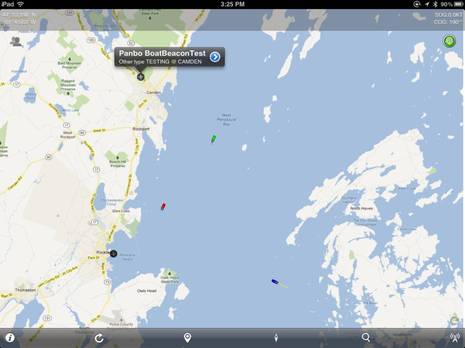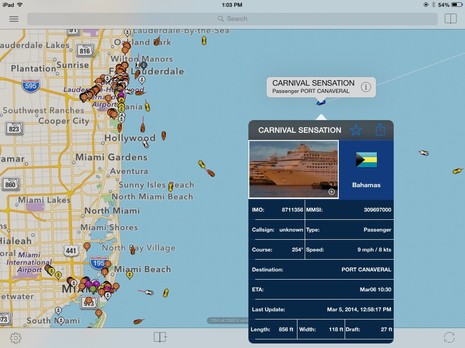ShipFinder iPhone/iPad giveaway, Happy Holidays
One of several things I like about the latest (2.29) version of the Ship Finder HD AIS viewer for the iPad is that when you zoom out you’ll see available targets grouped by the shore receivers that Ship Finder’s developer (“pinkfroot” is its unusual name) currently has access to. Some users seem to have a hard time getting the concept, but as I’ve written before, “the most important thing about a remote AIS viewer — be it on the Web,
or an iPhone, or wherever — has to be the data feeds it uses.” Pinkfroot now also has a free Web viewer that shows the same data feeds. The truth is that coverage around much of North America is pretty darn spotty and will stay that way until more of us set up receivers and give the data feeds to Pinkfroot and all the other developers who rebroadcast it for public enjoyment…
Still Ship Finder, and the others, are neat if a bit of coast you’re interested in is covered. And how nice of Pinkfroot to offer Panbo readers 15 free copies of the iPad editon {sorry, all gone}, along with 15 free copies of the iPhone edition {also all gone}. Just email iphone@panbo.com and be sure to tell me which version you want. First come, first served (and no restrictions on international iTunes accounts anymore).
The only other iPad-specific AIS viewer I have installed is FleetMon: Mobile Vesseltracking (actually it’s a “universal app”, but that concept works fine, while running iPhone apps on iPads doesn’t really). It’s more expensive than Ship Finder HD ($25 vs $8) and doesn’t have any more North American coverage, though that coverage includes some places Ship Finder doesn’t (and vice versa). But FleetMon Mobile (and the FleetMon web site) can search on a vessel’s last known position, which can be somewhat useful. For instance, here’s the Class B on my brother-in-law’s M/V Brilliant caught last July in Narragansett Bay…
 There aren’t many boats underway around New England today, or even planes. Pinkfroot also a Plane Finder HD app, seen below, and I don’t think the lack of targets anywhere near me are due to lack of volunteer receivers, but rather a blizzard causing gusts over 50 knots. (We still have electricity, but we’re not counting on it
There aren’t many boats underway around New England today, or even planes. Pinkfroot also a Plane Finder HD app, seen below, and I don’t think the lack of targets anywhere near me are due to lack of volunteer receivers, but rather a blizzard causing gusts over 50 knots. (We still have electricity, but we’re not counting on it 















Also available for Android, for €3.50. Reviews on the Market aren’t great. Pretty pricey. Think I’ll cool off on this one and/or wait for a free app. But good to see that such an App exists! Thanks Panbo!
I find marinetraffic.com to be far more comprehensive then shipfinder IMHO
Dave
I live in NYC and hardly ever see NY Harbor info.
I wonder if it is discouraged for security purposes.
AIS will be onboard S/V Jubilant this spring.
http://www.sailblogs.com/member/jubilant
The app is handy, and seems to do what it is supposed to, though there is precious little traffic in the Gulf of Maine and Bay of Fundy just now – may be the storm which just paralyzed the east coast, may be the time of year. A nice feature is the locator/bookmarker for places you want to check on frequently.
For an alterative which seems to have better coverage, at least around here, try http://www.marinetraffic.com/m, which is free. Don’t even think about marinetraffic.com (without the /m) on your iPhone, though – way too much data has to come down ever time you adjust the viewing area. the /m version has been optimized for tiny browsers on tiny screens.
Michael, VesselTracker (which also has a good iPhone app) has pretty good NYC coverage:
http://www.vesseltracker.com/en/Port/newyork/Map.html
But what would be the security purpose of limiting Web AIS viewing of NY (if that was possible), when any bad guy can buy an AIS receiver for a few hundred dollars?
PS 3 iPad and 5 iPhone redeem codes left!
A good example of the role of AIS receivers, and kind of fun: Ship Finder has good coverage of St. Martins, which today showed some megayachts heading to St. Barts for the big New Year’s thing there, but Marine Traffic has the same feed plus one on St. Bart’s itself, which reveals about 70 yachts there already. And check the tracks for the Tenders 3 and 5 near Le Grand Bleu; there’s a party going on. Hopefully the weather will be better than last year:
https://panbo.com/archives/2010/01/happy_new_year_rolling_in_st_barts.html
My fear is a terrorist abroad has a WMD on a container ship and wants to know as it nears Manhattan to remotely detonate it.
God forbid.
Geez, Michael, that is a grim thought. But it seems unlikely that terrorists would rely on volunteer AIS receiving stations.
A neat thing that Marine Traffic does is to map and detail some of its feeds (though they’re turned off by default). Unfortunately not all have identified themselves, so today, for instance, I can’t see what feed or feeds to supplying the New York harbor data. But I can see that South Street Seaport has a receiver which is offline right now. Volunteer networks are flaky by nature, which is why the more the better:
http://www.marinetraffic.com/ais/datasheet.aspx?datasource=STATIONS
For those of you worried about what a terrorist might do, it’s too late. Trying to shutdown or limit AIS services will shut the barn door after the horse are all gone. AIS is fundamentally a public broadcast. Limiting AIS services are likely to only hurt those with good intentions. The WMD scenario is pointless… why use an AIS network for this kind of thing? There are lots of communications techniques that work great for command, control, and location on a global basis. To give you one example that use all the time: iridium phones.
I encourage people interested in the topic to write out their thoughts in public. The USCG RFC about NAIS data release addresses some of these issues. Take a read of these.
* My comments to the USCG
* Eric Raymond’s comments. ESR is the lead author of GPSD, which now has AIS decoding support.
* All comments submitted to USCG for USCG-2009-0701
* Bruce Schneier talking about security in general
People are welcome to use that blog post for discussion.
Very interesting reading, Kurt; thank you. I had not realized that the USCG was considering opening NAIS data to some degree, and you make an excellent case for why they should do it completely.
But has the CG already made a decision about this?
Incidentally, I was discouraged to see in the submitted comments that both the NMMA and BoatUS took the stand that recreational boaters would be discouraged from using AIS transponders if they learned that their current and historical tracks might become part of the public record. I hope that discussion gets opened again, because I think I’m one of many boaters who don’t have a problem with it, and, in fact, realize that its already public information.
Ben,
Realtime release of NAIS data was actually authorized by Adm Thad Allen. He had me push NAIS positions of response vessels into http://www.geoplatform.gov/gulfresponse/ updated every 2 minutes. There has been an initial internal first draft statement enacted, but a final decision has not been made (as far as I know).
I have the same worry about AIS not being adopted for fear of tracking. People get very upset when they find out that they are being tracked. I personally feel that it best to let people know that their vessel will be tracked. I would rather have people opt in knowing what they are getting into rather than be rightfully upset after they discover they are being tracked (world wide these days). I wish for several reasons that more people would use AIS. Beyond the realtime safety assistance: If you don’t have AIS, you won’t be counted by NOAA and the USCG for your use of the waterways… that will lower their priority for work in your area. They don’t have enough resources to be everywhere, so they will like prioritize things like charting based on where they see AIS tracks of ships.
Maties, an amusing iPhone game called Ship It! is free today. Looks decent on an iPad too.
http://www.coracleonline.com/content/shipit.htm